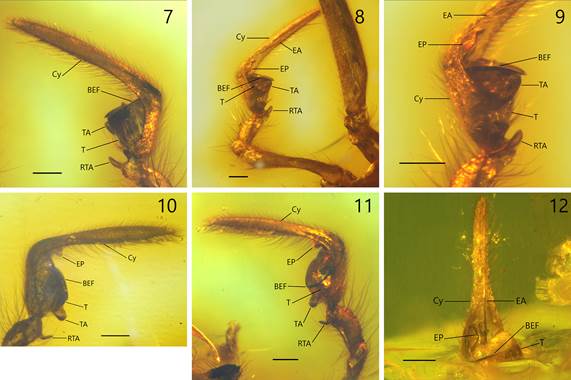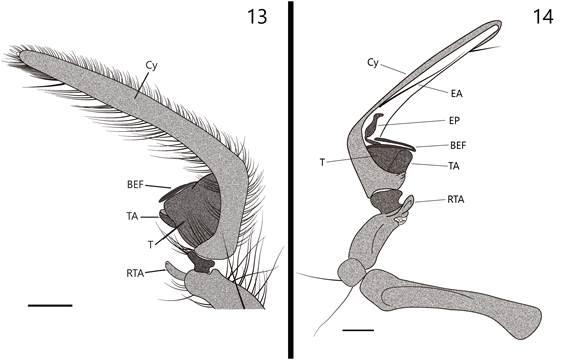Introduction
Bonaldo et al. (2012) reviewed the taxonomy of the American species of the genus StrotarchusSimon, 1888 (Araneae: Cheiracanthiidae). Bonaldo et al. (2012) considered as diagnostic characters: “the male palp with an elongate cymbium, tegulum with widely fused retrolateral apophysis, without hyaline conductor; embolus with a large base, abruptly narrowed distally, with a distinct median process; female epigynum with an anterior atrium, forming a copulatory pocket, without conspicuous copulatory openings”. The taxonomic history and the controversial family placement of this genus was summarized by Bonaldo et al. (2012). Later, Ramírez (2014) transferred Strotarchus to Eutichuridae, but Ono & Ogata (2018) considered Eutichuridae a junior synonym of Cheiracanthidae. This genus encompasses 20 extant (World Spider Catalog, 2022) and two fossil species (Dunlop et al., 2020). Among the extant species 18 are from the American continent (where 12 from Mexico) and two from Pakistan, these last considered as probably misplaced by Bonaldo et al. (2012). From a drawing of Strotarchus vittatusDyal, 1935 (plate XVII, fig. 151) it is evident that the epigynum of this species (from Pakistan) does not correspond to the diagnosis of Bonaldo et al. (2012) for Strotarchus.
Strotarchus paradoxus (Petrunkevitch, 1963) was the first fossil species described for this genus, known only from a female specimen from Mexican amber (Chiapas) (about 22.8-23 million years old, Vega et al., 2009; Serrano-Sánchez et al., 2015). This species was described under the genus name MimeutychurusPetrunkevitch, 1963, which is considered as a tentative junior synonym of Strotarchus by Dunlop et al. (2017). Strotarchus heidtiWunderlich, 1988, was the second fossil species described, known only from male specimens from Dominican Republic amber (about 20 million years old, Solórzano Kraemer, 2007). Here we describe for the first time the male of S. paradoxus, based on two adult male specimens, preserved in amber from Simojovel de Allende, Chiapas, Mexico and we propose a diagnosis for the species.
Materials and methods
The studied materials are two amber pieces of Miocene-Aquitanian from Simojovel de Allende, Chiapas, Mexico. One of these pieces was acquired from an amber trader in San Cristóbal de Las Casas (Chiapas), and the mine of precedence is unknown, this is deposited at the Colección de Arácnidos, El Colegio de la Frontera Sur, Tapachula, Chiapas (ECOTAAR-Fos001). The second amber piece comes from the Montecristo mine in Simojovel de Allende and is deposited at the Museo de Paleontología “Eliseo Palacios Aguilera”, Secretaría de Medio Ambiente e Historia Natural, Tuxtla Gutiérrez, Chiapas (IHNFG-5892). To obtain the best possible views of each specimen, each piece was cut and submitted to sanding and polished using water sandpaper of different degrees (500 SIC to 1500 SIC) and a liquid polisher (Braso ®) (García-Villafuerte, 2022). Photographs were obtained using a Cannon Eos Rebel SL3 mounted on a Zeiss Stemi 2000-C stereomicroscope, multiple focal plane images were stacked using Helicon Focus 6 software. Measurements were taken with an ocular micrometer on an Olympus SZX16 stereomicroscope and are noted in millimeters. Format of description follows Bonaldo et al. (2012) with modifications. Abbreviations: AC, aciniform gland spigots; aPLS, apical segment of posterolateral spinnerets; AME, anteromedian eyes; ALE, anterolateral eyes; ALS; anterolateral spinnerets; BEF, basal embolar fold; bPLS, basal segment of posterolateral spinnerets; Cy, cymbium; EA, embolar apex; EP, embolar process; PLE, posterolateral eyes; PLS, posterolateral spinnerets; PME, posteromedian eyes; PMS, posteromedian spinnerets; RTA, retrolateral tibial apophysis; T, tegulum; TA, tegular apophysis.
Results
Family Cheiracanthiidae Wagner, 1887
Genus Strotarchus Simon, 1888
Strotarchus paradoxus (Petrunkevitch, 1963)

Figures 1-6 Strotarchus paradoxus (Petrunkevitch, 1963) male (ECOTAAR-Fos001): 1) Habitus, dorsal view; 2) habitus, ventral view; 3) carapace, dorsal view; 4) carapace, ventral view; 5) opisthosoma, ventral view; 6) detail of PLS, ventral view. AC, aciniform gland spigots; aPLS, apical segment of posterolateral spinnerets; bPLS, basal segment of posterolateral spinnerets. Scale bars: 1, 4) 1 mm; 2, 3, 5) 0.5 mm; 6) 0.2 mm.

Figures 7-12 Strotarchus paradoxus (Petrunkevitch, 1963) male (figs. 7-11, ECOTAAR-Fos001): 7-9) Right palpus, 7) prolateral view; 8) retrolateral view; 9) detail of retrolateral view; 10-11) left palpus; 10) prolateral view; 11) retrolateral view; 12) (IHNFG-5892): right palpus, ventral view. BEF, basal embolar fold; Cy, cymbium; EA, embolar apex; EP, embolar process; RTA, retrolateral tibial apophysis; T, tegulum; TA, tegular apophysis. Scale bars: 7-12) 0.2 mm.

Figures 13-14 Strotarchus paradoxus (Petrunkevitch, 1963) male right palp diagrams: 13) Prolateral view; 14) retrolateral view. BEF, basal embolar fold; Cy, cymbium; EA, embolar apex; EP, embolar process; RTA, retrolateral tibial apophysis; T, tegulum; TA, tegular apophysis. Scale bars: 13-14) 0.2 mm.
Mimeutychurus paradoxusPetrunkevitch, 1963: 30, Plate 1, C; figures 93-109 (female holotype from Palo Blanco mine, 30 km NE Simojovel, Chiapas, Mexico, in University of California Museum of Paleontology No. 12726; not examined).
Strotarchus paradoxus: Dunlop et al. 2017: 181 (tentative synonymy).
Material examined: 1 male included in amber from Simojovel de Allende, Chiapas, Mexico, without data of mine (ECOTAAR-Fos001); 1 male included in amber from Montecristo mine in Simojovel de Allende, Chiapas, Mexico (IHNFG-5892).
Diagnosis: The male and female of S. paradoxus differ from all other species by having a thin apical segment of the posterior lateral spinnerets (PLS), with a ratio long/wide of about 0.11 (female, fig. 97 in Petrunkevitch, 1963) to about 0.13 (male, Fig. 6), while in other species this ratio is higher, about 0.25 for the male of S. heidti (fig. 620 in Wunderlich, 1988), 0.40 for the female of Strotarchus nebulosusSimon, 1888 (plate 6, fig. 14c in F. O. Pickard-Cambridge, 1899), or 0.50 for both sexes of Strotarchus piscatorius (Hentz, 1847) (figs 43, 47 in Bonaldo et al., 2012). Additionally, the male of S. paradoxus differs from all other species (with known male) by having an embolar process (EP) elongated, with a unique shape, wide at its base, slim at middle, and slightly widened at its apex (Figs. 9, 12, 14), and by having the palpal cymbium (Cy) bent 90°, with the dorsal border of the proximal part of the cymbium straight (Figs. 7-11, 13, 14), while in all other species (except S. heidti, fig. 621 in Wunderlich, 1988) this border is convex (see figures of male palps in Bonaldo et al., 2012). Furthermore, the female of S. paradoxus differs from all other species by having an epigynum with a large atrium, occupying the anterior half of epigynum (fig. 103 in Petrunkevitch, 1963), while in other species (except S. tlalocBonaldo et al., 2012) the atrium occupies less than half of the epigynum (see figures of female epigyna in Bonaldo et al., 2012).
Description: Female. See description by Petrunkevitch (1963, page 30, under Mimeutychurus paradoxus). Male (ECOTAAR-Fos001). The specimen is well preserved, but lacks left legs I, III, IV, and the distal part of leg II. It also has the carapace fractured on its left side, from its anterior border to the fovea, and the eyes are partially visible only on the right side (Fig. 1). Color description based on specimen preserved in amber: Carapace dark brown, with fovea darker. Chelicerae dark brown, with most of fang lighter. Labium and endites dark brown with white apex on labium. Legs dark yellow. Opisthosoma grey, venter dark yellow; spinnerets dark yellow with distal segment of PLS lighter (Figs. 1-6). Total length 4.40. Carapace 2.20 long, 1.35 wide. Eye diameters: AME 0.09, ALE 0.09, PME 0.10, PLE 0.07. Teeth on chelicerae not visible. Leg measurements: femur I 2.10/ II 1.95/ III 1.75/ IV 2.20; tibia I 2.18/ II 1.68/ III 1.30/ IV 2.00; metatarsus I 2.08/ II 1.70/ III 1.58/ IV 2.30; tarsus I 0.95/ II 0.80/ III 0.68/ IV 0.93. Palpus measurements: femur 1.16, patella 0.31, tibia 0.35, cymbium 1.60. Spinnerets (Figs. 3, 6): anterior lateral spinnerets (ALS) two segmented, separated by about twice their basal diameter, 0.62 long (basal segment 0.56, apical 0.06); posterior median spinnerets (PMS) one-segmented, 0.40 long; PLS two segmented, 1.08 long (basal segment 0.62, apical 0.46), apical segment with visible aciniform gland spigots (AC in Fig. 6). Leg spination: I femur d1-1-1, p0-1-1; tibia d0-1-0, p1-1-0, r1-1-0, v2-2-0; metatarsus d0-1-0, p1-1-2, r1-1-1, v2-2-1m. II femur d1-1-1, p0-1-1; tibia d0-1-0, p0-1-1, r1-1-0, v2-2-0; metatarsus d0-1-0, p1-1-2, r1-0-2, v2-2-1m. III femur d1-1-1, p0-1-1-1, r0-0-1; tibia d0-1-0, p1-0-1, r1-0-1, v1-2-0; metatarsus d0-1-1-0, p1-1-2, r1-1- 2, v2-2-1m. IV femur d1-1-1, p0-0-1, r0-0-1; tibia p1-1-0, r1-1-0, v1m-1m-2-0; metatarsus p1-1-2, r1- 1-2, v2-2-1r. Palpal femur strongly arched ventrally (Fig. 1, left palpus), tibiae length about one third of the femur length (Fig. 1, right palpus); retrolateral tibial apophysis (RTA) long, spoon-shaped at its distal end (Figs. 7-11, 13, 14); apical lamella of RTA and prolateral process of RTA absent. Cymbium long, bent 90°, the dorsal border of the proximal part straight (Figs 7-11, 13, 14), its distal part slender, almost tubular, about two and a half the length of the wider, proximal part (Figs. 7, 8, 10, 11, 13, 14). Tegulum (T) large, occupying most of bulb (Figs. 7-11, 13, 14); tegular apophysis (TA) long, on retrolateral margin of T (Figs. 8, 9, 11, 14); basal embolar fold (BEF) narrow, traversing apical portion of T (Figs. 7-9, 11, 13, 14); embolar process (EP) about as long as RTA (Figs. 8, 9, 12, 14); embolar apex (EA) long, very thin, arising prolaterally (Figs. 8, 12, 14).
Variation: Second male (IHNFG-5892), total length 4.23. Carapace 1.88 long, 1.43 wide; femur I 2.03/ II 1.75; ALS 0.53; PLS 1.04 (0.66+0.38). This male is not so well preserved as the other, it has several legs broken; the amber piece has many fractures, and the specimen is surrounded by artifacts on several parts, all these affect the visibility of structures. Fortunately, the spinnerets and both palps are partially visible, including part of the bulb of the right palp in ventral view (Fig. 12), structures that agree with those of the other male (ECOTAAR-Fos001).
Discussion
Taxonomic assignment. The diagnostic characters of the genus Strotarchus, as stated by Bonaldo et al. (2012) (PLS with long apical segment, ALS widely separated, male with elongated cymbium, T with widely fused TA, embolus with large base abruptly narrowed distally and with a median process) let us clearly identified the studied fossil specimens as members of this genus. The studied males are assigned to S. paradoxus by the following considerations. First, they were found on the same area and geological period as the female described by Petrunkevitch (1963). Second, the males have similar size and form to that of the female in carapace and specially in the apical segment of the PLS of this species, which is proportionally thinner than in other species, and very similar to the drawing of Petrunkevitch (1963, fig. 99) of the aciniform gland spigots (AC in Fig. 6). Third, they differ from S. heidti and from the known males of the extant species by the thin apical segment of the PLS and by the characteristic form of the EP.
The extant species of Strotarchus are ground dwellers, found under stones and plant detritus, or wandering on the surface (Kaston, 1948; Edwards, 1958; Richman, 2017). The behavior of S. paradoxus was probably often wandering on the surface under the foliage of the Hymenaea trees known to exude resin that later becomes amber. The fact of have found two pieces with S. paradoxus male specimens indicate this species was seemingly common in the lowland tropical dry forest of the middle Miocene in the Simojovel area (Solórzano Kraemer, 2007). Most of Strotarchus species are found in Mexico; the genus is widely distributed in states from north, central and some southern states, such as Guerrero and Oaxaca (Bonaldo et al., 2012). However, none of the extant species have been found in the Simojovel area, or even in the state of Chiapas. It is possible that future intensive inventories of spider fauna in this area could reveal the presence of any Strotarchus species.











 nueva página del texto (beta)
nueva página del texto (beta)



